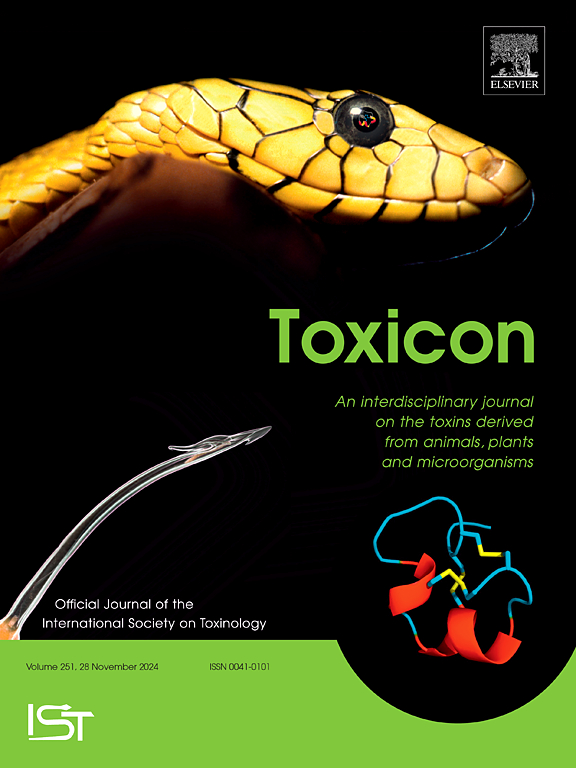蝎子蜇伤中的新生物标志物。
IF 2.6
4区 医学
Q2 PHARMACOLOGY & PHARMACY
引用次数: 0
摘要
蝎子蜇伤的死亡率为0.16%,大多数死亡发生在儿童身上。目前可用于诊断由蝎子蜇伤(最常见的死亡原因)引起的心功能障碍的资源是超声心动图和实验室检查,如肌钙蛋白、肌酸磷酸激酶mb (CKMB)和脑利钠肽(BNP)。本研究旨在评估生物标志物可溶性抑制致瘤性2 (sST2)和心脏型脂肪酸结合蛋白(FABP3)在检测蝎子蜇伤患者心功能障碍中的准确性。这项工作是一项前瞻性横断面研究,于2020年12月至2022年5月期间进行,患者年龄在0-19岁之间,被蝎子蜇伤。收集所有入院时有严重症状的患者的血清或血浆样本,并用标准化的心脏损伤生物标志物试剂盒进行检测。并与心脏超声检测的心功能障碍进行比较。本研究纳入49例患者,多数为女性(51%),中位年龄3.6岁。左心室功能障碍13例(26.5%),重度7例。sST2和FABP-3的生物标志物显示与左心室功能障碍相关,auc分别为0.77和0.81。两种生物标志物的临界值显示灵敏度为92.3%。超敏肌钙蛋白AUC为0.89,灵敏度为84.6%。该研究显示sST2和FABP-3之间的关联,以及急性心功能障碍的存在,通过心脏超声识别。与肌钙蛋白类似,这两种生物标记物在识别有心脏损伤迹象的患者方面表现出敏感性。与心功能障碍相关的结果可能与早期发现心脏病变和亚临床功能障碍有关,从而实现更快、更有效的干预。本研究的局限性包括样本量小,数据收集在单一中心,以及缺乏生物标志物的连续测量。本文章由计算机程序翻译,如有差异,请以英文原文为准。

New biomarkers in scorpion stings
Scorpion stings have a fatality rate of 0.16%, with the majority of deaths occurring in children. The resources currently available for diagnosing cardiac dysfunction caused by scorpion stings, the most common cause of death, are echocardiograms and laboratory tests, such as troponin, creatine phosphokinase-MB (CKMB), and Brain natriuretic peptide (BNP). The present study aims to evaluate the accuracy of the biomarkers soluble Supression tumorigenicity 2 (sST2) and Heart-type fatty-acid-binding protein (FABP3) in detecting cardiac dysfunction in patients stung by scorpions. This work is a prospective cross-sectional study, carried out between December 2020 and May 2022, with patients, aged 0–19 years, stung by a scorpion. Serum or plasma samples from all patients with signs of severity upon hospital admission were collected and tested with standardized cardiac damage biomarker kits. The results were compared with cardiac dysfunction detected by cardiac ultrasound. This study included 49 patients, the majority female (51%), with a median age of 3.6 years. Left ventricular dysfunction was identified in 13 patients (26.5%), with 7 cases classified as severe. The biomarkers of sST2 and FABP-3 showed an association with left ventricular dysfunction, presenting AUCs of 0.77 and 0.81, respectively. The cut-off values determined for both biomarkers showed a sensitivity of 92.3%. Ultrasensitive troponin presented an AUC of 0.89, with a sensitivity of 84.6%. The study showed an association between sST2 and FABP-3, as well as the presence of acute cardiac dysfunction, identified by cardiac ultrasound. Both biomarkers demonstrated sensitivity in identifying patients with signs of cardiac damage, similar to troponin. The results related to cardiac dysfunction may be linked to the early detection of cardiac lesions and subclinical dysfunctions, enabling faster and more effective interventions. Limitations of this study include the small sample size, data collection in a single center, and the lack of serial measurements of biomarkers.
求助全文
通过发布文献求助,成功后即可免费获取论文全文。
去求助
来源期刊

Toxicon
医学-毒理学
CiteScore
4.80
自引率
10.70%
发文量
358
审稿时长
68 days
期刊介绍:
Toxicon has an open access mirror Toxicon: X, sharing the same aims and scope, editorial team, submission system and rigorous peer review. An introductory offer Toxicon: X - full waiver of the Open Access fee.
Toxicon''s "aims and scope" are to publish:
-articles containing the results of original research on problems related to toxins derived from animals, plants and microorganisms
-papers on novel findings related to the chemical, pharmacological, toxicological, and immunological properties of natural toxins
-molecular biological studies of toxins and other genes from poisonous and venomous organisms that advance understanding of the role or function of toxins
-clinical observations on poisoning and envenoming where a new therapeutic principle has been proposed or a decidedly superior clinical result has been obtained.
-material on the use of toxins as tools in studying biological processes and material on subjects related to venom and antivenom problems.
-articles on the translational application of toxins, for example as drugs and insecticides
-epidemiological studies on envenoming or poisoning, so long as they highlight a previously unrecognised medical problem or provide insight into the prevention or medical treatment of envenoming or poisoning. Retrospective surveys of hospital records, especially those lacking species identification, will not be considered for publication. Properly designed prospective community-based surveys are strongly encouraged.
-articles describing well-known activities of venoms, such as antibacterial, anticancer, and analgesic activities of arachnid venoms, without any attempt to define the mechanism of action or purify the active component, will not be considered for publication in Toxicon.
-review articles on problems related to toxinology.
To encourage the exchange of ideas, sections of the journal may be devoted to Short Communications, Letters to the Editor and activities of the affiliated societies.
 求助内容:
求助内容: 应助结果提醒方式:
应助结果提醒方式:


